Abstract: This article details historical records and specimens from Somerset of the extinct Large Blue Maculinea arion subspecies eutyphron (Fruhstorfer, 1915). There is also an account of I.R.P. Heslop's mid 20th century discoveries of M. arion in Somerset at previously unrecorded localities.
Historical butterfly specimens are a valuable study resource, especially those that have associated data labels that provide details of locality and date of capture. A search was made in several museum collections for specimens of the Large Blue from Somerset and any accompanying data was also examined to give a complete picture of the Large Blue's former distribution in the county. Various British Lepidoptera collections were also visited, at the Hope Department of Entomology at the Oxford University Museum of Natural History (OUMNH), at the British Museum of Natural History (BMNH) in London, at Bristol City Museum and at the Somerset Heritage Centre in Taunton.
The Large Blue was first recorded in the county of Somerset on the hills near Bath (Lewin, 1795). The next record of this butterfly was from the Langport area in South Somerset. John Quekett (1815-1861), the famous London microscopist, discovered a population of M. arion near Langport in 1833 (Newman, 1834). This locality was on the low limestone ridge above the village of Aller, just to the north of Langport (Dale, 1836). John Quekett wrote 'I took about forty specimens on the 15th June 1833, in a situation abounding with long grass and brambles at Langport near Taunton; and on the same day in 1834, I took twenty specimens, and Mr Dale ten' (Newman, 1871). John Quekett visited the same locality on several occasions and always had similar success (Newman, 1871).
James Charles Dale (1791-1872), the respected entomologist and wealthy squire of Glanvilles Wootton, visited the Langport area to collect insects. Dales diaries, held in the Library of the Hope Department at Oxford, give a brief but valuable record of his visits to Langport between 1834 and 1845. In his entomological journals there is list of localities that he visited in 1834. Dale was collecting at Langport on the 14th May 1834 and again on the 23rd June of that year. Surprisingly, based on his diary entries (Dale, 1808-1835), he failed to record his visit on the 15th June 1834 when he was collecting M. arion with John Quekett. The following year, on 22nd June 1835, Dale took seven M. arion on Aller Hill north of Langport. In 1836 Dale returned and is recorded as collecting in the Langport area, both on Aller and High Ham Hills and in nearby Breach Wood. He records in his diary for 1836 that 'M. arion was in plenty and it was on the wing with the Brown Argus Aricia agestis' (Dale, 1835-1865) and a now extinct limestone race of the Silver-studded Blue Plebejus argus (based on specimens in the Dale collection, whose labels give Langport as the locality). Dale's next visit to the Langport area was in July 1839, when the Large Blue was again plentiful on Aller Hill. 1843 appears to be the last year that Dale found M. arion in this locality when he took four males on June 26th. When collecting on Aller Hill and in Breach Wood on the 29th June and 1st July 1845, Dale recorded no further captures of M. arion.
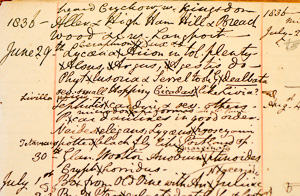 |
| Figure 1 - Extract from a page from J.C. Dale's diary (1835-1865). He found the Large Blue Maculinea (Lycaena) arion in plenty at Langport on June 29th 1836. Image © OUMNH |
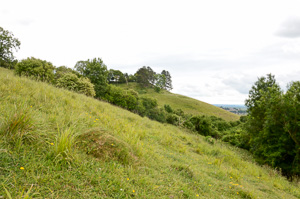 |
| Figure 2 - Aller Hill, a historic locality for M. arion Image © Peter Andrews |
Two other local collectors, who were friends of John Quekett, the bankers William John Paul (1817-1896) and John Woodland (date of birth unknown), also captured a number of specimens of M. arion from Langport in the early part of the 19th century (Hudd, 1906). 1843 was believed to be the last year that the Large Blue was found at Langport (Salmon, 2000). Thomas and Emmet (1990) state that there were two small colonies near Langport. Butterfly Conservation (2011) mentions that, historically, Aller Hill supported a large population of the Large Blue in the early 1800s.
The main ridge of the Polden Hills lies between Puriton near Bridgewater, in the west, to Butleigh near Street, in the east. The first record of M. arion from the Polden Hills was that of John Quekett. He found the Large Blue in profusion near Glastonbury (Morris, 1853). Thomas and Emmet wrote the section on the Large Blue in The Moths and Butterflies of Great Britain and Ireland (Emmet and Heath, 1990), mentioning that there were three sites for M. arion in the Polden Hills. They included the two colonies near Langport within this area.
A single specimen of Large Blue was reported from Weston-super Mare by W.D. Crotch in the middle of the 19th century (Hudd, 1906). There seems to be no reports of further captures of the Large Blue from this area during 19th century and I have been unable to find any known extant specimens.
Specimens from Somerset are known to be rare in collections (Emmet and Heath, 1990). The small series of fine specimens of M. arion collected by J.C. Dale at Langport are held in the Dalean Collection in the Hope Department of Entomology at Oxford. Considering that Dale collected M. arion in 1834, 1835, 1839 and 1843 at Langport, there is a surprisingly small number of specimens in his collection. Dale, like many of his contemporaries, also collected specimens for exchange (Brown, 1980).
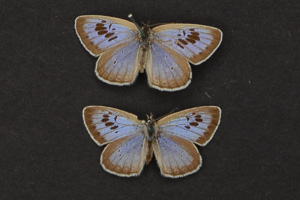 | 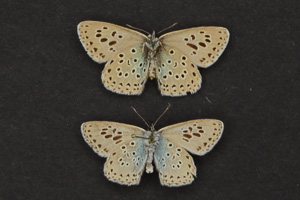 |
| Image © Peter Andrews | Image © Peter Andrews |
| Figures 3, 4 - Specimens of the Large Blue M. arion captured by J.C. Dale near Langport in Somerset Image © OUMNH |
In a letter dated January 1901, William Bidgood, the curator of the Taunton Museum, wrote to A.E. Hudd of Bristol saying that William John Paul (1871-1896) from Langport had collected a long series of M. arion from that locality and he had given a pair to their collection (Hudd, 1906). In the Taunton Lepidoptera collection, which is now housed at the Somerset Heritage Centre, there is a small series of seven specimens of M. arion set with early British pins. The specimens of M. arion are without data labels but, placed underneath two examples, is a handwritten note that reads 'Langport 2'. This almost certainly refers to the two specimens presented to the museum by William John Paul. The specimens were found in the W.G. Rawlinson collection that had been presented to the Taunton museum during 1878. By the time W.G. Rawlinson (1840-1928) of Taunton was in the field collecting butterflies, the Large Blue had disappeared from the Langport locality. It is possible that the complete M. arion series in the Rawlinson collection were all captured by a collector at Langport at an earlier date. John Woodland of Langport also presented a cabinet to the Taunton museum in 1864, with six Langport specimens of M. arion, but his collection was in poor condition and is now missing (Sutton, 1993). The collection of John Quekett and his brother Edwin did not survive (Sutton, 1993).
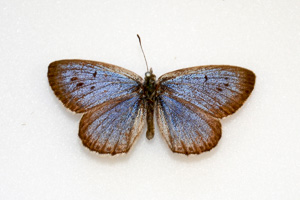 | 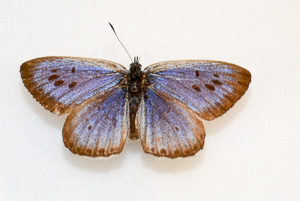 |
| Image © Peter Andrews | Image © Peter Andrews |
| Figures 5, 6 - Probable M. arion specimens from Langport presented to the Taunton Museum by W.J. Paul Image © Collections of the Taunton Heritage Centre |
A study was made of the extensive collection of the British M. arion ssp. eutyphron specimens at the BMNH. Unfortunately, many of the 19th century collectors did not place data labels on their specimens. Compared to the large numbers of M. arion specimens from the large colonies that were once known in North Devon, North Cornwall and the Cotswolds, there are only a few specimens in the BMNH Museum collections from Somerset. There are several specimens that have data which reads 'Somerset, R. Salway 25th April 1892'. Unfortunately, those specimens have no other locality details and the Salway specimens were certainly not taken in April; the Large Blue flies in a single brood during during June and July (Thomas and Lewington, 2010). Interestingly Heslop (1964) records that the Large Blue was last seen during the 19th century in Somerset around 1880. There are also a few specimens from Langport in the British Museum.
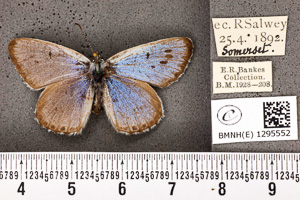 | 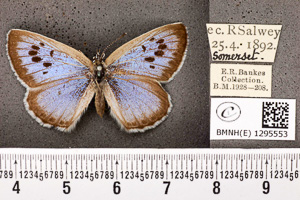 |
| Image © BMNH | Image © BMNH |
| Figures 7, 8 - Specimens of M. arion R. Salway. Somerset 1892 |
Ian Heslop was born in India in 1903 and later attended Clifton College at Bristol. Leaving Cambridge University in 1928, he joined the colonial service in Nigeria but occasionally returned to his Burnham-on-Sea home to collect butterflies in Somerset (Barnett et al., 2003). A record of M. arion from North Somerset by Heslop at Brockley Combe on the 8th of July 1945 certainly surprised his fellow entomologists and caused considerable controversy (Barnett et al., 2003). Heslop wrote in the Entomologist for 1945 'I was reclining on a clump of heather in order to rest a lame foot when I was astonished to see a Large Blue come flying towards me. It gave me an excellent view of itself as it fluttered over some flowers at two paces distance while I was struggling to my feet'.
Heslop failed to capture the specimen at Brockley Combe. In his diaries held at the Bristol Museum, Heslop mentions that he was accompanied by another famous collector of high standing, the Baron Charles de Worms. Both Heslop and de Worms were known to be expert field lepidopterists (Salmon, 2000; Oates, 2005), There were no previous records from Brockley Combe and there have been none since (Barnett et al., 2003).
The Baron Charles de Worms confirmed to John Muggleton, who was then at Bristol University, that he and Heslop had indeed seen the specimen distinctly which confirmed the record as genuine (Barnett et al., 2003). This single record of M. arion seems to be the source of John Muggleton's mention that the Clevedon Hills were a locality for this species (Muggleton and Benham, 1975).
In The Entomologist for 1949, Heslop described a search for the Purple Emperor and of rediscovering M. arion in Somerset. During his search, Heslop mentions that he found five specimens of the Large Blue at two widely separated localities in the south of the county and that one was captured (Heslop, 1949). Heslop only placed the county names on his specimen data labels, almost certainly because he was believed in keeping his localities confidential. Even when writing about his butterfly adventures in journals, Heslop gave no locality details. An examination of Heslop's private diaries, housed in the Bristol City Museum, is essential to find further information. The diaries reveal that the M. arion specimen taken on the 11th July 1949 was one of three seen at Butleigh in the Polden Hills. When Heslop had found the Large Blue at Butleigh, the colony was by that time heading towards extinction at that site (Oates, 2005). This specimen is to be found in the Heslop collection that was presented to the Bristol City Museum. The Large Blue taken by Heslop at Butleigh, is the only known Somerset specimen from the 20th century.
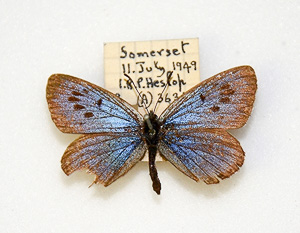 |
| Figure 9 - The only known 20th century Somerset specimen of M. arion. Captured by I.R.P. Heslop at Butleigh in the Polden Hills Image © Peter Andrews |
The Baron Charles de Worms (de Worms, 1970) revealed that during 1949 Heslop had also discovered the Large Blue in a new locality, the Quantock Hills, where it was previously unrecorded. This new site was referred to as being a limestone outcrop (Muggleton and Benham, 1975). In Heslop's diaries there is no mention of this discovery. Matthew Oates (Oates, 2005) explained that Heslop only usually recorded actual captures of specimens in his diaries. The Large Blue site in the Quantocks was later destoyed by quarrying (Oates, 2005). A colony of the Large Blue was rediscovered 5km from the original Langport locality in 1945 and survived to the 1950's (Thomas and Emmet, 1990).
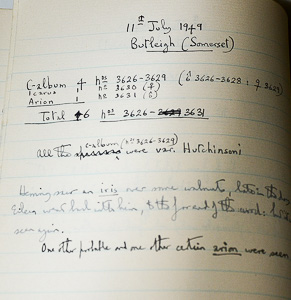 |
| Figure 10 - A Page from Ian Heslop's diary revealing Butleigh in the Polden Hills as the locality where he had found the Large Blue during 1949 Image © Bristol City Museum |
A geographical cline was present in the extinct British population of the Large Blue (Muggleton, 1975). Individuals from Barnwell Wold in Northamptonshire and the Cotswold Hills were a darker shade of blue than those found in Cornwall and North Devon (Ford, 1945). It has been suggested that the Somerset populations were intermediate between the two races (Muggleton, 1975). Ford (1945) mentioned that the Langport specimens of M. arion were of the darker shade of blue than those from Devon and Cornwall and were similar to those that occurred in the Cotswold populations. Ford (1945) also found that the M. arion specimens at Oxford that were collected by J.C. Dale from the Langport locality were remarkable for the large size of their spots, both on the uppersides and undersides. Spooner (1963) suggested that the cline that was present in the endemic races of the British M. arion was due to the geographic isolation of the different populations over a long period of time.
M. arion may have become extinct in Somerset through changes in its habitat. In John Quekett's account of the capture of M. arion at Langport, his mention of long grass and brambles (Newman, 1871) may have led to the habitat becoming unsuitable. The larval foodplant, Thymus polytrichus, and the host red ants, Myrmica sabuleti, both need a short, close-cropped sward (Thomas and Lewington, 2010). James William Tutt (1858-1911), the distinguished but forthright entomologist, had other ideas for the extinction of M. arion at Langport. He blamed Quekett and other collectors for exterminating this species in Somerset (Tutt, 1896).
The account of Quekett's discovery of the Large Blue near Langport in 1833 first appeared a year later in the Entomological Magazine (Newman, 1834). Only J.C. Dale and the local Langport collectors are known to have visited Aller Hill to collect the Large Blue. The actual site for M. arion near Langport appears not to have been widely known. I have been unable to trace any further accounts of other collectors who visited this locality for specimens.
Spooner (1963) disagrees that collectors were the main reason for the extinction of any M. arion population in Britian. He states that, in nearly all the localities which were visited by collectors, the populations of M. arion remained stable until the disappearance of the foodplant through scrub invasion and a longer grass sward. Spooner (1963) found that, even at sites where there was no collecting, M. arion disappeared just as quickly when the habitat changed. Only as the Large Blue declined through habitat change and by other adverse conditions, such as prolonged wet weather during the flight period, could collecting have been a significant contributing factor to the Large Blue's survival (Spooner, 1963).
During 1992, the Large Blue Maculinea arion ssp. arion was successfully reintroduced to the Polden Hills in Somerset from Swedish stock. Today, the Polden Hills support the strongest British populations. The creation of suitable habitat on currently unoccupied sites has focused on sites west of the main Poldens Ridge, with an epicentre of Aller Hill SSSI (Butterfly Conservation, 2011).
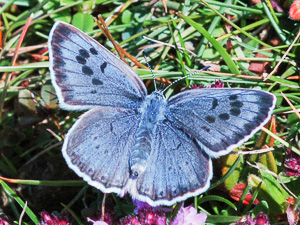 |
| Figure 11 - The reintroduced Swedish Large Blue at Collard Hill in Somerset. Image © Peter Andrews |
A study of the records and specimens of M. arion has shown this was always a very local butterfly in Somerset. The two strongest colonies were near Langport (Newman, 1871) and on the Polden Hills near Glastonbury (Morris, 1853). The other records of single specimens, such as at Weston-super Mare (Hudd, 1906) and Brockley Combe in the Clevedon Hills (Heslop, 1945), point to perhaps butterflies that have strayed from small colonies that soon became extinct after these sightings were made. Heslop's discoveries show that, although being much scarcer than formerly, the Large Blue was not extinct in Somerset when it disappeared from Quekett's Langport locality as suggested by Tutt in 1896; M. arion continued to occur in this county up to the middle of the 20th century (Heslop, 1949; Emmet and Heath, 1990).
I would like to thank the following for their kind help in allowing access to specimens and records: Rhian Rowland of the Bristol City Museum, Dennis Parsons of the Taunton Heritage Centre, James Hogan of the Hope Department of Entomology at the Oxford University Museum of Natural History (OUMNH), Kathleen Santry of the Hope Entomological Library (OUMNH) and Geoff Martin at the British Museum of Natural History. Also John Palmer of the Dorset Natural History and Archaeological Society.